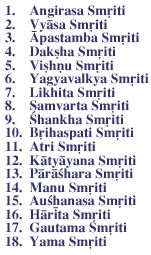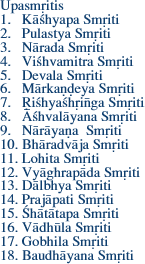| |
 |
 |
|
|
|
 |
 |
 |
 |
 |
 |
|


Smriti is one of the structuring dynamics of Rk Veda. It highlights
the quality of MEMORY involved in structuring Rk Veda.
With reference to consciousness, Smriti comprises the specific
sets of laws of Nature that are engaged in promoting the quality
of Rishi — the observer, the witnessing quality —
within the Samhita level of consciousness, providing a structure
to the eternally silent, self-referral, self-sufficient, fully
awake state of consciousness, which is intimately personal
to everyone. (complete table
of qualities)
|
 |
 |
 |
|
In the physiology, Smriti is represented by
all the memory systems and reflex arcs, which allow
action and perception to occur without the need for lengthy
processing and analysis.
This happens on the basis of complete knowledge, or memory, of what should be the appropriate response to any situation, . . . as well as the appropriate response to more complex adjustments of social and traditional behavior in the presence of changing circumstances or environmental needs.
 |
 |
 |
 |
 |
 |
— Prof. Tony
Nader-Ram in Human Physiology: Expression of Veda and
the Vedic Literature,
pp. 176-177 |
|
 |
|
 |
 |
 |


|
| |
 
  
Download all 18 Smritis
in one file (2.1 MB)

|
|
|
 |
| |